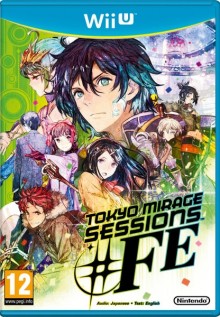Tokyo Mirage Sessions #FE (Wii U) Review
By Brandon (Michael) Howard  30.06.2016
30.06.2016

Tokyo Mirage Sessions #FE has come a long way from the game announced at E3 several years ago. Originally envisioned as a crossover between Nintendo's Fire Emblem and Atlus' Shin Megami Tensei, it's taken on its own life as a JRPG inspired by the world of Japan's biggest idols. Tokyo Mirage Sessions #FE has definitely taken a step away from either of its parent series, and it marches to its own tune. While it might not exactly be what fans had in mind, there's a lot of charm to be had in this stylish, colourful Wii U exclusive.
A cursory glance at the combat system and overall theming of Tokyo Mirage Sessions #FE gives off a vibe more reminiscent of the Persona series, rather than one that directly takes from either Fire Emblem or Shin Megami Tensei. It's fitting, though, since, as one of the more beloved spin-offs of the mainline SMT series, the Persona games have certainly delivered on strong world building and characters, and that's no different here. It's safe to say that Tokyo Mirage Sessions #FE is very much a Persona game, seasoned with Fire Emblem's own unique flair.
The combat system specifically will feel right at home to players of more recent Persona titles. Each character has a Mirage based on a Fire Emblem character from either Fire Emblem: Shadow Dragon, or the more recent Fire Emblem: Awakening. Functioning much the same to the titular Personas of that series, each has their own selection of physical abilities and spells, and their own weaknesses and resistances. Pressing those advantages gives a massive edge in combat, allowing skilled planners to end battles before their enemies have a chance to react.

Combat starts through enemies encountered in dungeons, where lead character Itsuki can get a jump on them with a quick swing of his sword, giving the team an edge in combat. Given the dungeon mapping and the slightly awkward camera controls, however, starting up fights can get a little awkward, but it's nothing too serious. Encounters themselves are frequent, but not to the point where they become a chore, especially considering the addictive natures of the battle system.
There's still plenty of elements that will feel familiar to fans of either series, however. Fire Emblem's famous weapon triangle returns, functioning much the same way as in its home series. The spells, instead of the rather pedestrianly named ones from Fire Emblem, are borrowed from Shin Megami Tensei. Both conventions do add a bit of familiarity, but the number of named skills is pretty impressive, and might come across as overwhelming to those unfamiliar with them.
Also borrowed from Fire Emblem is the rather infamous random stat increases that accompany each level up. Rather than the more common strict stat progression used in SMT games, the stat progression is wholly random this time around. Characters are more likely to develop stats that benefit them more, but it's still a rather annoying system to deal with when level ups can be manipulated just by reloading a save before hitting the level up mark. It begins to feel compulsory to get the best increases, and that can take quite a few tries.

Characters also earn mastery over their equipped weapon with each battle, offering their Mirage additional combat skills, either active or passive. Weapons can be forged in a special room between dungeons, and there's quite a variety that will unlock over the course of the game, so there's no shortage of skills to unlock. It's a bit annoying that it has to be done in a separate area, and sometimes a portion of experience will be wasted on fully mastered weapons, but it's not a glaring issue.
All the systems work perfectly, but for a title that's supposedly taken so much inspiration from Fire Emblem, a lot of the borrowed elements feel entirely thematic, rather than gameplay oriented. Everything is well done, but they really could have pushed the crossover one step further. Other elements feel better represented, however, and, strangely, make something that seems out of place fit right in.

Aside from their notably challenging combat systems, both Shin Megami Tensei and Fire Emblem employ a great deal of emphasis on their character writing, and Tokyo Mirage Sessions #FE is no different. The characters are likable, and feel very well written for the age range they're targeting. All the interactions between them feel believable and genuine, and they're easy to like in a short amount of time. Integrating a texting dialogue into the Wii U GamePad adds to the interactivity of the conversations, although its usage does feel a little superfluous.
The characters are all voiced in Japanese, and the dialogue sounds great. The voice actors have all done an outstanding job, and the soundtrack sounds wonderful, being one heavily influenced by the idol scene itself. The subtitles are a bit of an odd note; they work perfectly fine most of the time, but are completely absent in battles. The little battle quips don't exactly need a translation, but there are short voiced segments during certain encounters that could have benefited from captioning.

Cubed3 Rating
Exceptional - Gold Award

Tokyo Mirage Sessions #FE steals the spotlight with gorgeous visuals, memorable characters, and fast-paced, slightly over the top combat. While the gameplay won't exactly feel familiar to long time Fire Emblem fans, the characters and the relationships that they share will feel comfortingly familiar. While the developers could have gone a little further to stay true to the original inspiration for the game, there's still a lot to love about the brilliant and colourful idol-centric setting. Ultimately, Tokyo Mirage Sessions #FE delivers an encore worthy performance.

![]() 9/10
9/10
![]() 0
(0 Votes)
0
(0 Votes)
 Out now
Out now  Out now
Out now  Out now
Out now  Out now
Out now Comments
Comments are currently disabled

 Sign In
Sign In Game Details
Game Details Subscribe to this topic
Subscribe to this topic Features
Features





 Top
Top

